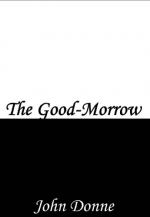
|
| Name: _________________________ | Period: ___________________ |
This quiz consists of 5 multiple choice and 5 short answer questions through Section 1: "The Good Morrow," lines 1-21.
Multiple Choice Questions
1. Lines 12-14, "Let sea-discoverers to new worlds have gone,/ Let maps to other, worlds on worlds have shown,/ Let us possess one world, each hath one, and is one," contain an example of which technique?
(a) Antimetabole.
(b) Anaphora.
(c) Onomatopoeia.
(d) Cacophony.
2. What is different about the poem's first two and last two lines?
(a) They have fewer syllables than the others.
(b) They are enjambed.
(c) They are addressed to a different audience.
(d) They do not rhyme.
3. Which term best describes the rhyming in lines 13 and 14, "Let maps to other, worlds on worlds have shown,/ Let us possess one world, each hath one, and is one"?
(a) Eye rhyme.
(b) Slant rhyme.
(c) Identical rhyme.
(d) True rhyme.
4. Who is the author of "The Good Morrow"?
(a) Andrew Marvell.
(b) Henry Vaughan.
(c) George Herbert.
(d) John Donne.
5. Which term describes this poem most accurately?
(a) Apostrophe.
(b) Epistle.
(c) Dialogue.
(d) Aside.
Short Answer Questions
1. What does the phrase "'Twas so" in line 5 mean?
2. Which word in lines 15-18 is meant to contrast the impermanent nature of life outside the lovers' relationship with the eternal nature of their love?
3. The mention of the Seven Sleepers in line 4 is an example of which technique?
4. In line 14, "Let us possess one world, each hath one, and is one," what two things are being compared?
5. Line 10, "For love, all love of other sights controls," contains an example of which technique?
|
This section contains 298 words (approx. 1 page at 300 words per page) |

|




